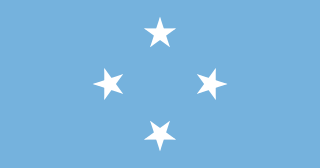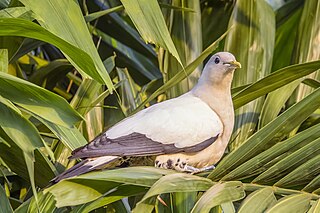
The Federated States of Micronesia, or simply Micronesia, is an island country in Micronesia, a subregion of Oceania. The federation consists of four states—from west to east, Yap, Chuuk, Pohnpei and Kosrae—that are spread across the western Pacific. Together, the states comprise around 607 islands that cover a longitudinal distance of almost 2,700 km (1,700 mi) just north of the equator. They lie northeast of Indonesia and Papua New Guinea, south of Guam and the Marianas, west of Nauru and the Marshall Islands, east of Palau and the Philippines, about 2,900 km (1,800 mi) north of eastern Australia, 3,400 km (2,100 mi) southeast of Japan, and some 4,000 km (2,485 mi) southwest of the main islands of the Hawaiian Islands.

The flag of the Federated States of Micronesia was adopted on 30 November 1978. The blue field represents the Pacific Ocean. In an echo of U.S. heraldic practice, the stars represent the four federated states: Chuuk, Pohnpei, Kosrae and Yap, arranged like the points of the compass.

The green imperial pigeon is a large forest pigeon. The large range extends from Nepal, southern India and Sri Lanka eastwards to southern China, Indonesia and the Philippines.

The pied imperial pigeon is a relatively large, pied species of pigeon. It is found in forest, woodland, mangrove, plantations and scrub in Southeast Asia, ranging from Myanmar and Thailand, throughout Indonesia and east to the Philippines and the Bird's Head Peninsula in New Guinea. It is mainly found on small islands and in coastal regions. It remains locally common, and is therefore considered to be of least concern by BirdLife International and IUCN.

The Key West quail-dove is a species of bird from the doves and pigeon family Columbidae. It is probably most closely related to the bridled quail-dove.

Ducula is a genus of the pigeon family Columbidae, collectively known as imperial pigeons. They are large to very large pigeons with a heavy build and medium to long tails. They are arboreal, feed mainly on fruit and are closely related to the other genus of fruit-eating doves, Ptilinopus. Both genera display brightly coloured plumage, predominantly green, often with contrasting under-parts of purple, orange or red. Some Ducula have prominently swollen ceres. They have large gapes and swallow seeds whole, playing an important role in seed dispersal.
The Vanuatu imperial pigeon or Baker's imperial pigeon is a species of bird in the family Columbidae. It is endemic to Vanuatu and lives in forests. It is threatened by forest clearing, and the International Union for Conservation of Nature (IUCN) has assessed it as a vulnerable species.
The chestnut-bellied imperial pigeon is a species of bird in the family Columbidae. It is endemic to the southern Solomon Islands.
The spotted imperial pigeon, also known as the grey-necked imperial pigeon, is a species of bird in the family Columbidae. Endemic to the Philippines, it lives in forests and forest edges but goes down to the limestone shorelines possibly to feed. It is a vulnerable species threatened by habitat loss and hunting.

The white-bellied imperial pigeon is a species of bird in the pigeon family Columbidae. First described by the French ornithologist Charles Lucien Bonaparte in 1854, it is endemic to Indonesia, where it is found on Sulawesi, Buton, Taliabu, Togian, and Peleng. It inhabits primary forest, dense secondary forest, and isolated areas of hill forest. A large pigeon with a long tail, it measures 42.5–51.5 cm (16.7–20.3 in) long and weighs 510 g (18 oz) on average. Males are mainly green, with pale-grey heads and bellies, chestnut vents, and a pale grey tail band, along with a red orbital ring. Females are nearly identical, but have darker grey areas in their plumage.

The black imperial pigeon, also known as the Bismarck imperial pigeon, is a species of bird in the pigeon family, Columbidae. First described by English zoologist Philip Sclater in 1878, it is endemic to the Bismarck Archipelago, where it mainly inhabits rainforest and cloud forest in mountain areas above 500 m (1,600 ft). It is a large, heavily-built imperial pigeon, with a length of 38–43 cm (15–17 in) and a weight of 661–665 g (23.3–23.5 oz). Adults are almost entirely black, except for the dark chestnut undertail coverts, the silvery-grey underside of the tail, and a pale grey scaly pattern on the wings and back. Both sexes look alike. Juveniles differ from adults in having paler undertail coverts.

The Pacific imperial pigeon, Pacific pigeon, Pacific fruit pigeon or lupe is a widespread pigeon species in the family Columbidae. It is found in American Samoa, the Cook Islands, the smaller islands of eastern Fiji, Kiribati, Niue, the smaller satellite islands of Papua New Guinea, Samoa, Solomon Islands, Tokelau, Tonga, Tuvalu, Vanuatu, and Wallis and Futuna Islands.

The Torresian imperial pigeon, also known as the nutmeg pigeon, white nutmeg pigeon, Australian pied imperial pigeon or Torres Strait pigeon, is a relatively large, pied species of pigeon. It is found in forest, woodland, savanna, mangrove and scrub in Australia, New Guinea, Aru Islands, islands in the Geelvink Bay, D'Entrecasteaux Islands and Louisiade Archipelago.

The Palau ground dove is a species of bird in the family Columbidae. It is endemic to Palau, living in forests. The IUCN has assessed it as an endangered species.
The Wetar ground dove is a species of bird in the family Columbidae found on Wetar, Indonesia, and on Timor. Its natural habitats are monsoon forests and gallery forests, and possibly woodland and bamboos. Threatened by habitat loss and hunting, the species is assessed as endangered by the IUCN.

The Micronesian myzomela is a species of bird in the honeyeater family Meliphagidae. The species forms a superspecies with a number of related and similar looking island and mainland myzomelas across the Pacific and Australasia. It in turn is composed of seven insular subspecies.
The 8th Micronesian Games were held from July 20 to July 30, 2014, in Pohnpei, Federated States of Micronesia (FSM).
Athletics competitions at the 2014 Micronesian Games were held at the Pohnpei Track and Field in Palikir, Pohnpei, between July 21–24, 2014.

The Carolines tropical moist forests is a tropical and subtropical moist broadleaf forests ecoregion in Micronesia. It includes the central and eastern Caroline Islands in the Federated States of Micronesia.
Football competitions have were first held at the Micronesian Games for the 1998 edition of the tournament. The event is open to the ten member federations of the Micronesian Games Council, a sub-regional member of the Oceania National Olympic Committees. The football tournament has been held at two subsequent games since 1998, in 2014 and 2018. Although a similar football tournament called the Micronesian Cup was held in 1999 and 2001, they were separate events as no Micronesian Games were held in those years.















